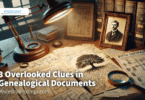What is a genealogical abstract? It is something you may come across in the research of other people when you are exploring records. Plainly speaking, an abstract in genealogy is an inventory of the most important details of a genealogical document. Abstracts are usually used when people are researching in the field and do not have the means or the permission to make a photocopy or computerized scan of a document. They can use abstracting to quickly get all the important points out of the document, so they can input it into their research on their family tree software later.
The trick to abstracting is to be able to quickly scan a genealogical document and decide what is really important to know and what can be left out. You want to include the important names, dates, and places, such as:
- Names of parents
- Names of children
- Names of grandparents
- Names, including maiden names, of spouses
- Place where the document was written
- Residence of your ancestor in the document
- Date the document was written
- Any other pertinent dates in the document, such as birth, death, and marriage dates
- Dates and places for military service
- Place of birth, death, and marriage
- Place of birth, death, and/or marriage of parents
These are just some examples of the information you want to copy off of a genealogical document for your abstract. Once you have looked at a large number of genealogical documents, you will get an idea of what is the most important information for your research. You will also become adept at quickly scanning a document to get that information and write it down.
When abstracting, always cite the source at the bottom of your abstract. This is so you can go back and look at the whole thing again later if you need to, since there may be interesting personal information on your ancestor in the document that doesn’t end up in the abstract, but that you may want to record to give you additional information on your ancestor’s personality. It may not be necessary for including in your research at that moment, but it is something you will want to include at some point.
Always bring a notepad and pen or pencil with you when you go to archive buildings, courthouses, and other places where original documents are located. Sometimes, the documents are too delicate to be photocopied or scanned, so abstracting them is the only way to get information from them. If there is only one useful document there, you may have time to transcribe the whole thing, but in most trips, you will be working with the orginial document, and you won’t have the time necessary to transcribe them all before the repository closes and your trip is over.
With your abstract, you can get important information from documents that have not been published online, and put that information in your research when you get home. Everyone has their own preferred method of abstracting, so do what works best for you. Just remember, the goal of producing an abstract is to get the most important genealogical information, the information that will further your research in new ways. Once you know how and when to use an abstract, you will see their genealogical value.






